Abstract
The period protein (PER) is a essential component of the circadian clock in Drosophila melanogaster. Although PER-containing pacemaker cells have been previously identified in the brain, the neuronal network that comprises the circadian clock remained unknown. Here it is shown that some PER neurons are also immunostained with an antiserum against the crustacean pigment-dispersing hormone (PDH). This antiserum reveals the entire arborization pattern of these pacemaker cells. The arborizations of these neurons are appropriate for modulation of the activity of many neurons and they might interact with PER-containing glial cells. A putative physiological role of PDH in the circadian system is discussed.
Full text
PDF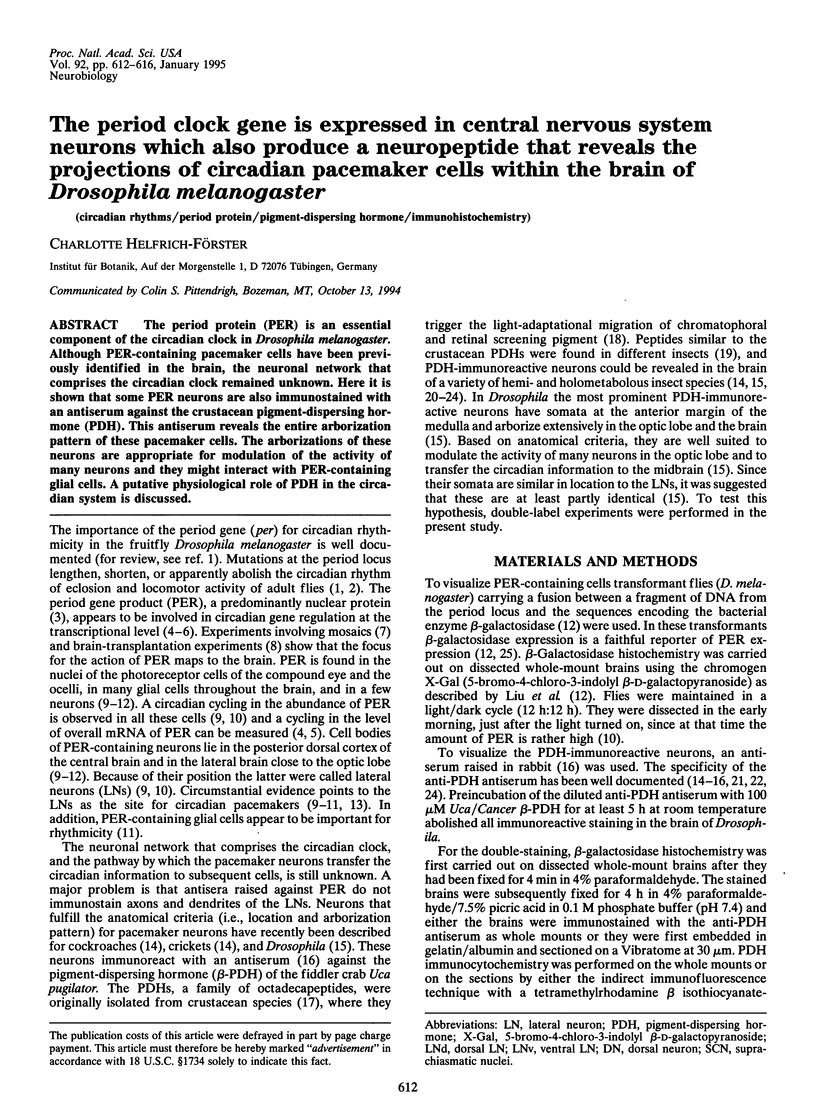
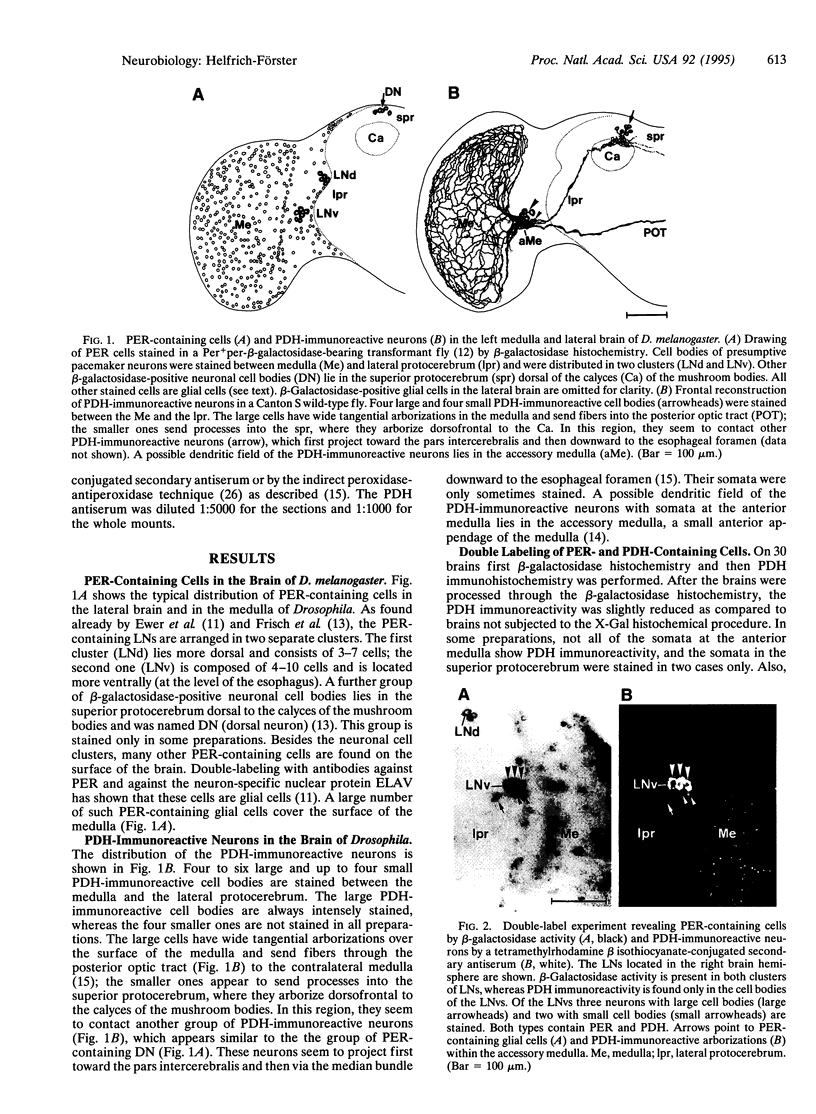
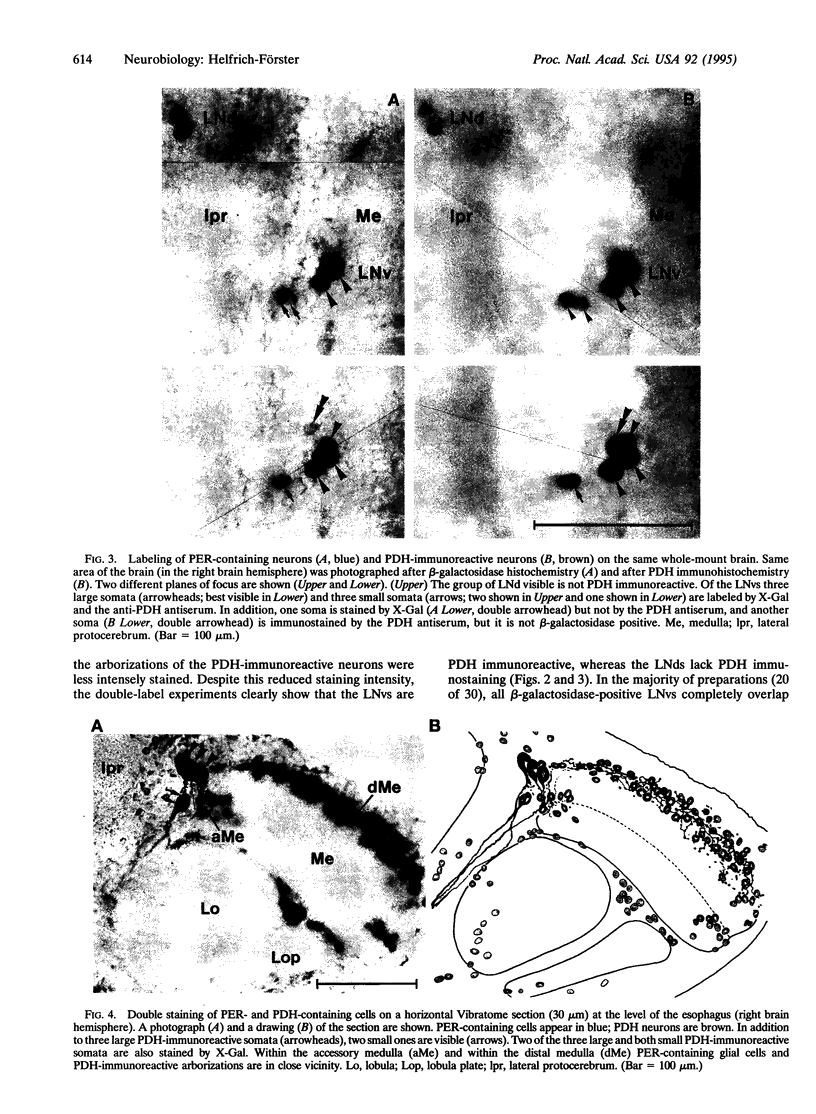
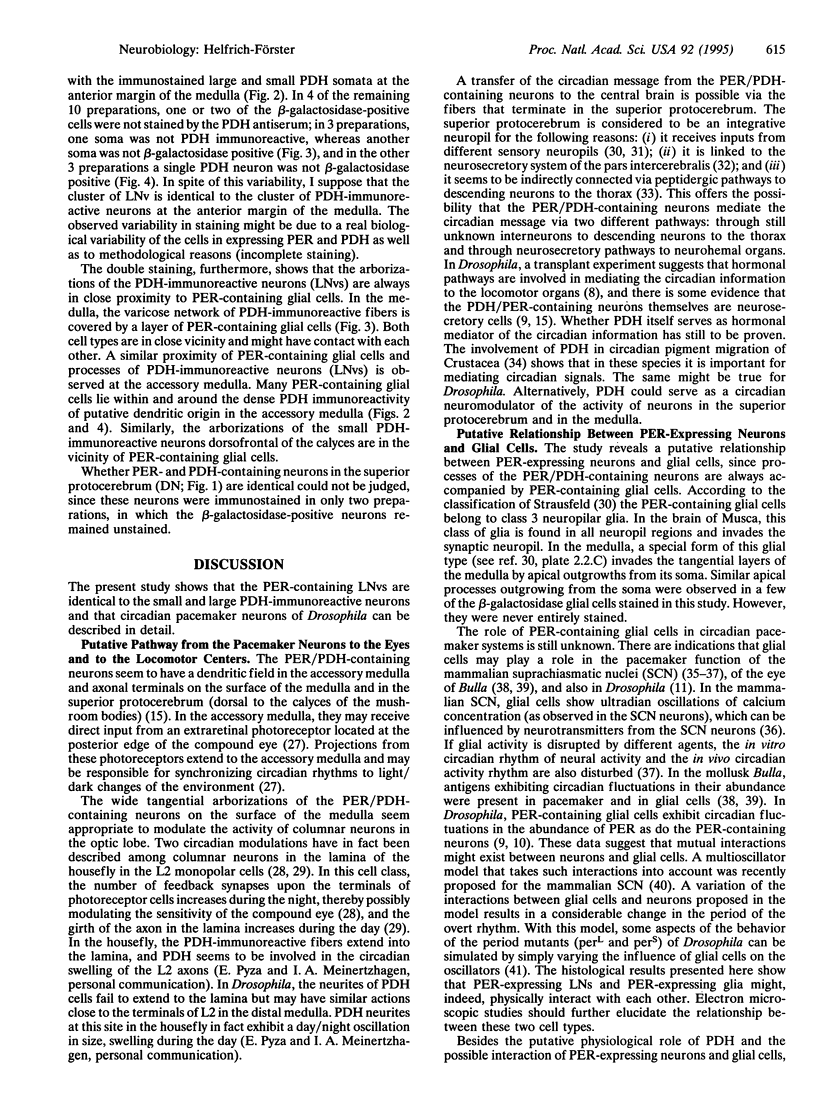
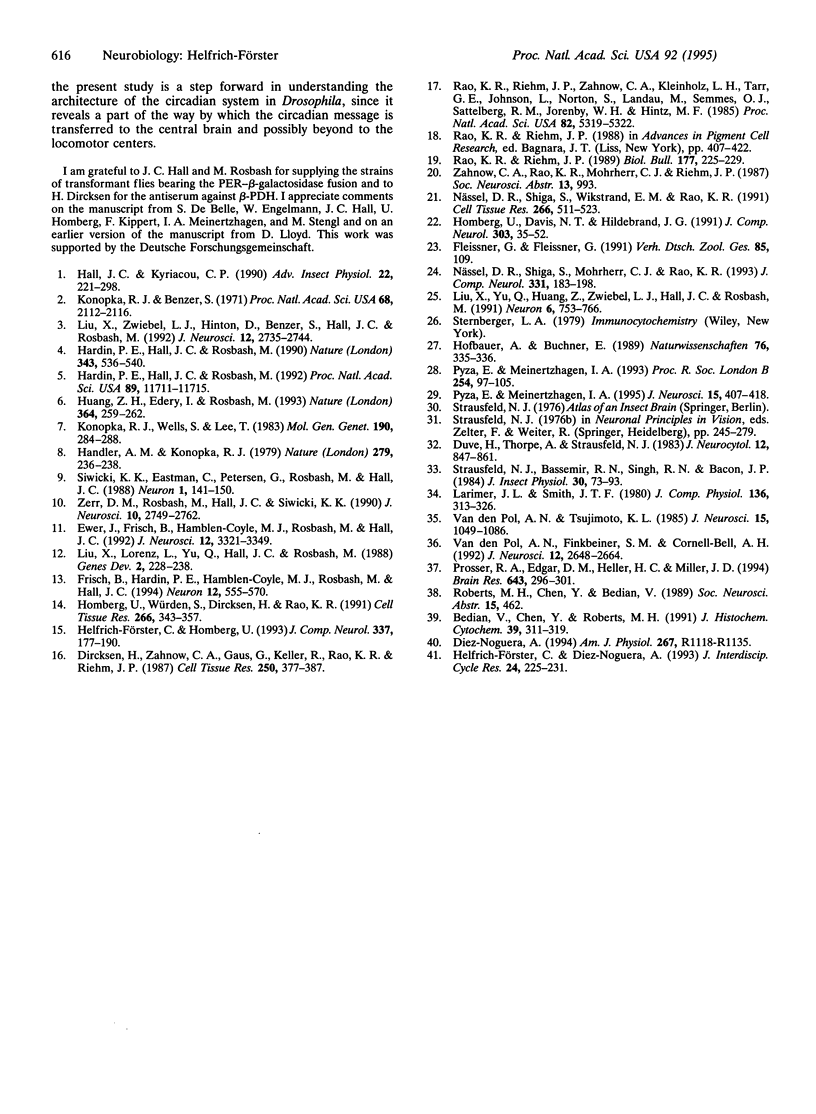
Images in this article
Selected References
These references are in PubMed. This may not be the complete list of references from this article.
- Bedian V., Chen Y. L., Roberts M. H. Monoclonal antibodies recognize localized antigens in the eye and central nervous system of the marine snail Bulla gouldiana. J Histochem Cytochem. 1991 Mar;39(3):311–319. doi: 10.1177/39.3.1993829. [DOI] [PubMed] [Google Scholar]
- Duve H., Thorpe A., Strausfeld N. J. Cobalt-immunocytochemical identification of peptidergic neurons in Calliphora innervating central and peripheral targets. J Neurocytol. 1983 Oct;12(5):847–861. doi: 10.1007/BF01258155. [DOI] [PubMed] [Google Scholar]
- Díez-Noguera A. A functional model of the circadian system based on the degree of intercommunication in a complex system. Am J Physiol. 1994 Oct;267(4 Pt 2):R1118–R1135. doi: 10.1152/ajpregu.1994.267.4.R1118. [DOI] [PubMed] [Google Scholar]
- Ewer J., Frisch B., Hamblen-Coyle M. J., Rosbash M., Hall J. C. Expression of the period clock gene within different cell types in the brain of Drosophila adults and mosaic analysis of these cells' influence on circadian behavioral rhythms. J Neurosci. 1992 Sep;12(9):3321–3349. doi: 10.1523/JNEUROSCI.12-09-03321.1992. [DOI] [PMC free article] [PubMed] [Google Scholar]
- Frisch B., Hardin P. E., Hamblen-Coyle M. J., Rosbash M., Hall J. C. A promoterless period gene mediates behavioral rhythmicity and cyclical per expression in a restricted subset of the Drosophila nervous system. Neuron. 1994 Mar;12(3):555–570. doi: 10.1016/0896-6273(94)90212-7. [DOI] [PubMed] [Google Scholar]
- Handler A. M., Konopka R. J. Transplantation of a circadian pacemaker in Drosophila. Nature. 1979 May 17;279(5710):236–238. doi: 10.1038/279236a0. [DOI] [PubMed] [Google Scholar]
- Hardin P. E., Hall J. C., Rosbash M. Circadian oscillations in period gene mRNA levels are transcriptionally regulated. Proc Natl Acad Sci U S A. 1992 Dec 15;89(24):11711–11715. doi: 10.1073/pnas.89.24.11711. [DOI] [PMC free article] [PubMed] [Google Scholar]
- Hardin P. E., Hall J. C., Rosbash M. Feedback of the Drosophila period gene product on circadian cycling of its messenger RNA levels. Nature. 1990 Feb 8;343(6258):536–540. doi: 10.1038/343536a0. [DOI] [PubMed] [Google Scholar]
- Helfrich-Förster C., Homberg U. Pigment-dispersing hormone-immunoreactive neurons in the nervous system of wild-type Drosophila melanogaster and of several mutants with altered circadian rhythmicity. J Comp Neurol. 1993 Nov 8;337(2):177–190. doi: 10.1002/cne.903370202. [DOI] [PubMed] [Google Scholar]
- Homberg U., Davis N. T., Hildebrand J. G. Peptide-immunocytochemistry of neurosecretory cells in the brain and retrocerebral complex of the sphinx moth Manduca sexta. J Comp Neurol. 1991 Jan 1;303(1):35–52. doi: 10.1002/cne.903030105. [DOI] [PubMed] [Google Scholar]
- Huang Z. J., Edery I., Rosbash M. PAS is a dimerization domain common to Drosophila period and several transcription factors. Nature. 1993 Jul 15;364(6434):259–262. doi: 10.1038/364259a0. [DOI] [PubMed] [Google Scholar]
- Konopka R. J., Benzer S. Clock mutants of Drosophila melanogaster. Proc Natl Acad Sci U S A. 1971 Sep;68(9):2112–2116. doi: 10.1073/pnas.68.9.2112. [DOI] [PMC free article] [PubMed] [Google Scholar]
- Liu X., Lorenz L., Yu Q. N., Hall J. C., Rosbash M. Spatial and temporal expression of the period gene in Drosophila melanogaster. Genes Dev. 1988 Feb;2(2):228–238. doi: 10.1101/gad.2.2.228. [DOI] [PubMed] [Google Scholar]
- Liu X., Yu Q. A., Huang Z. S., Zwiebel L. J., Hall J. C., Rosbash M. The strength and periodicity of D. melanogaster circadian rhythms are differentially affected by alterations in period gene expression. Neuron. 1991 May;6(5):753–766. doi: 10.1016/0896-6273(91)90172-v. [DOI] [PubMed] [Google Scholar]
- Liu X., Zwiebel L. J., Hinton D., Benzer S., Hall J. C., Rosbash M. The period gene encodes a predominantly nuclear protein in adult Drosophila. J Neurosci. 1992 Jul;12(7):2735–2744. doi: 10.1523/JNEUROSCI.12-07-02735.1992. [DOI] [PMC free article] [PubMed] [Google Scholar]
- Nässel D. R., Shiga S., Mohrherr C. J., Rao K. R. Pigment-dispersing hormone-like peptide in the nervous system of the flies Phormia and Drosophila: immunocytochemistry and partial characterization. J Comp Neurol. 1993 May 8;331(2):183–198. doi: 10.1002/cne.903310204. [DOI] [PubMed] [Google Scholar]
- Nässel D. R., Shiga S., Wikstrand E. M., Rao K. R. Pigment-dispersing hormone-immunoreactive neurons and their relation to serotonergic neurons in the blowfly and cockroach visual system. Cell Tissue Res. 1991 Dec;266(3):511–523. doi: 10.1007/BF00318593. [DOI] [PubMed] [Google Scholar]
- Prosser R. A., Edgar D. M., Heller H. C., Miller J. D. A possible glial role in the mammalian circadian clock. Brain Res. 1994 Apr 18;643(1-2):296–301. doi: 10.1016/0006-8993(94)90036-1. [DOI] [PubMed] [Google Scholar]
- Pyza E., Meinertzhagen I. A. Daily and circadian rhythms of synaptic frequency in the first visual neuropile of the housefly's (Musca domestica L.) optic lobe. Proc Biol Sci. 1993 Nov 22;254(1340):97–105. doi: 10.1098/rspb.1993.0133. [DOI] [PubMed] [Google Scholar]
- Pyza E., Meinertzhagen I. A. Monopolar cell axons in the first optic neuropil of the housefly, Musca domestica L., undergo daily fluctuations in diameter that have a circadian basis. J Neurosci. 1995 Jan;15(1 Pt 1):407–418. doi: 10.1523/JNEUROSCI.15-01-00407.1995. [DOI] [PMC free article] [PubMed] [Google Scholar]
- Rao K. R., Riehm J. P., Zahnow C. A., Kleinholz L. H., Tarr G. E., Johnson L., Norton S., Landau M., Semmes O. J., Sattelberg R. M. Characterization of a pigment-dispersing hormone in eyestalks of the fiddler crab Uca pugilator. Proc Natl Acad Sci U S A. 1985 Aug;82(16):5319–5322. doi: 10.1073/pnas.82.16.5319. [DOI] [PMC free article] [PubMed] [Google Scholar]
- Siwicki K. K., Eastman C., Petersen G., Rosbash M., Hall J. C. Antibodies to the period gene product of Drosophila reveal diverse tissue distribution and rhythmic changes in the visual system. Neuron. 1988 Apr;1(2):141–150. doi: 10.1016/0896-6273(88)90198-5. [DOI] [PubMed] [Google Scholar]
- Zerr D. M., Hall J. C., Rosbash M., Siwicki K. K. Circadian fluctuations of period protein immunoreactivity in the CNS and the visual system of Drosophila. J Neurosci. 1990 Aug;10(8):2749–2762. doi: 10.1523/JNEUROSCI.10-08-02749.1990. [DOI] [PMC free article] [PubMed] [Google Scholar]
- van den Pol A. N., Finkbeiner S. M., Cornell-Bell A. H. Calcium excitability and oscillations in suprachiasmatic nucleus neurons and glia in vitro. J Neurosci. 1992 Jul;12(7):2648–2664. doi: 10.1523/JNEUROSCI.12-07-02648.1992. [DOI] [PMC free article] [PubMed] [Google Scholar]
- van den Pol A. N., Tsujimoto K. L. Neurotransmitters of the hypothalamic suprachiasmatic nucleus: immunocytochemical analysis of 25 neuronal antigens. Neuroscience. 1985 Aug;15(4):1049–1086. doi: 10.1016/0306-4522(85)90254-4. [DOI] [PubMed] [Google Scholar]





